overall vitality
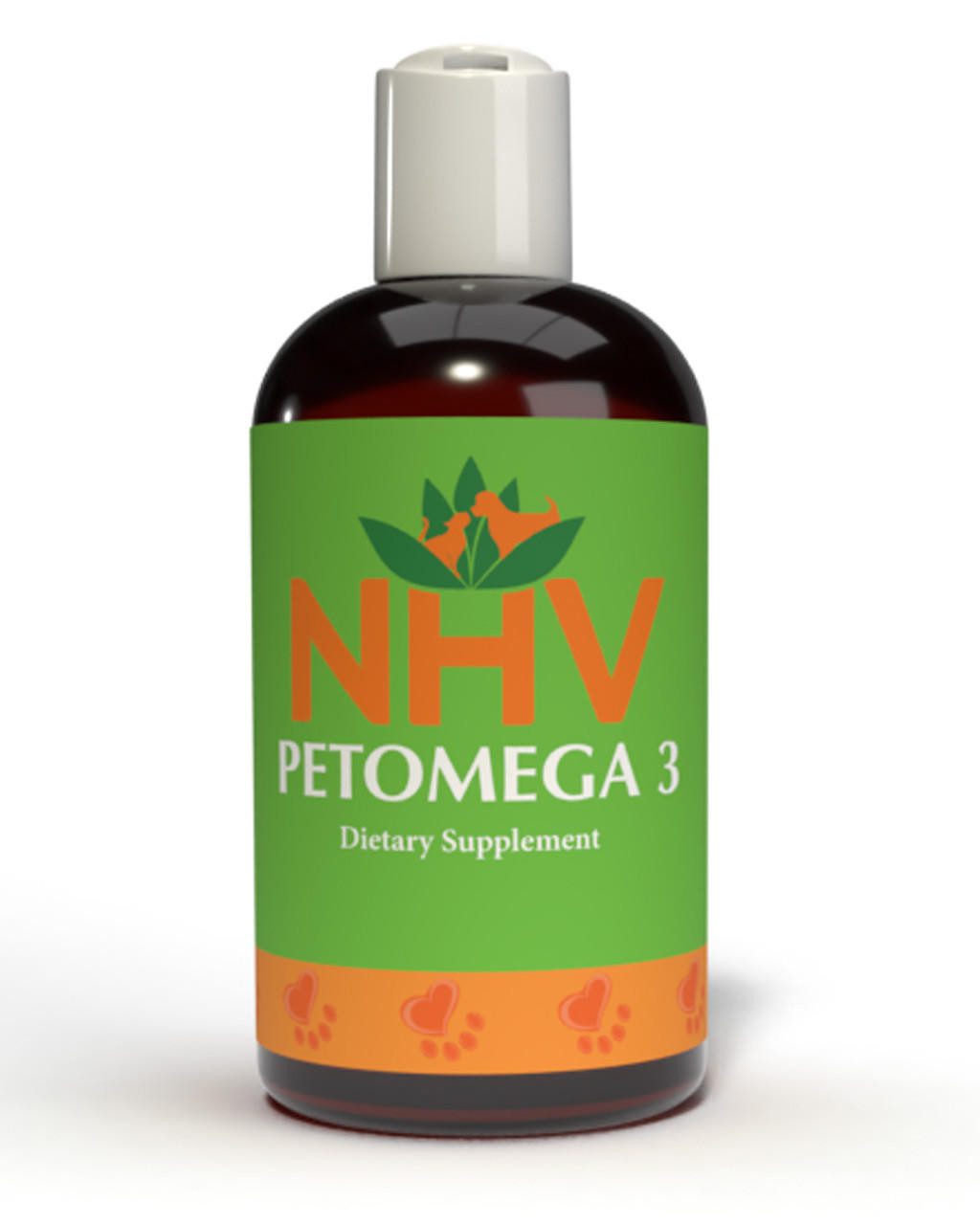
free shipping over $100 (USA & Canada)
1-877-937-4372 the pet expert hotline
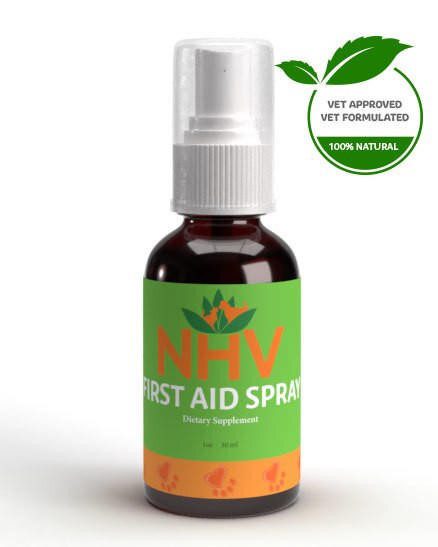
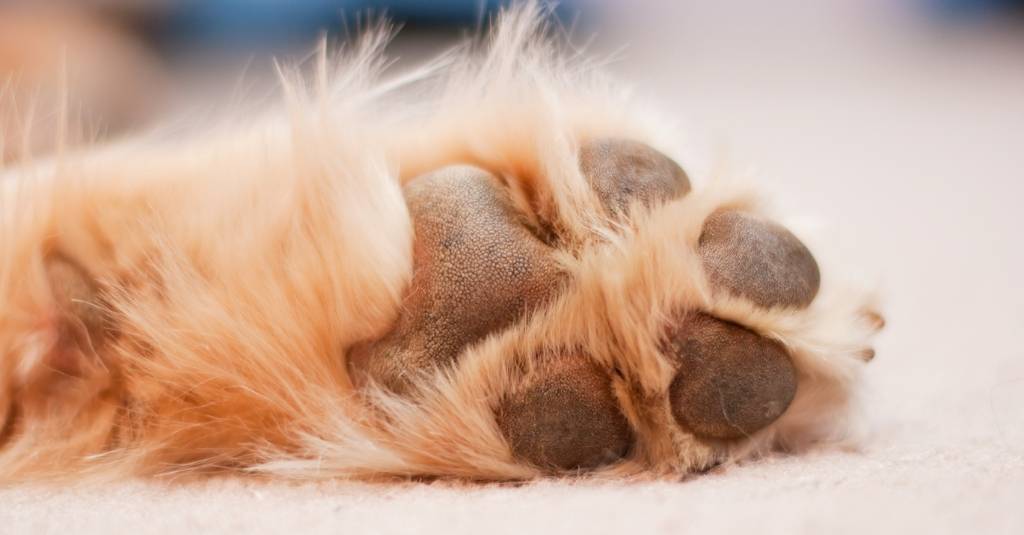
A common but relatively simple condition I’ve seen in my clinical experience is ingrown toenails. Just like our own finger and toenails, pets’ nails or ‘claws’ are constantly growing. Due to the generally curved shape of dog or cat nails, when they grow too long the nails tend to damage the skin and become “ingrown”. This is especially common in pets with longer fur because it can be difficult to see their nails under their long coat and the ingrown nails can easily go unnoticed. Though this is an uncomfortable condition, pets often won’t complain much about it. The discomfort increase very slowly as the nail grows and pets are very good at adapting to those changes. Most owners of pets who have ingrown nails are surprised when they are found during a routine trip to the clinic.
If not caught at this stage the nail will eventually break through the skin and begin to grow inside the flesh of the paw.
At the beginning stages of ingrown toenails, the nail simply pushes against the skin and causes inflammation. If not caught at this stage the nail will eventually break through the skin and begin to grow inside the flesh of the paw. This is obviously quite uncomfortable, but again, pets rarely show their discomfort with this problem. In dogs, nails take longer to grow into the flesh, as their nails are generally blunter than in cats. Dog nails may also curl outwards rather than into the paw pad if allowed to grow too long. Cat’s nails tend to become thickened as they age. The layers of the nail which often shed as the nail grows to fail to do so in many older cats. This can increase the likelihood of ingrown nails in senior cats.
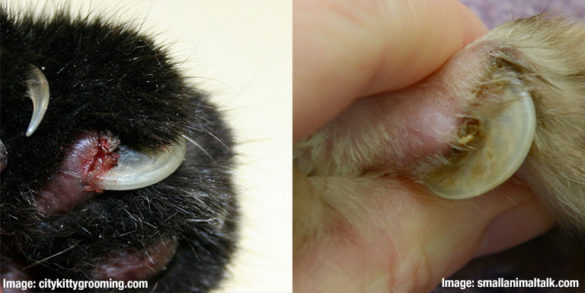
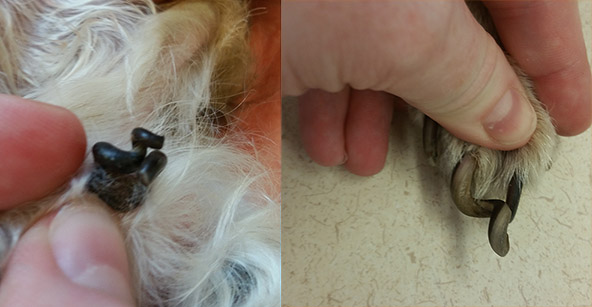
If your pet is found to have an ingrown nail, your veterinarian will likely clip the hair around the nail and trim all of your pet’s other nails. The affected nail is left to last, as it can be quite uncomfortable to clip and remove the nail from the flesh. The wound is then flushed and cleaned to remove any foreign material. Some pets will require a bandage on their foot, depending on the severity of the growth. If the risk of infection is high, your vet may also prescribe antibiotics. This also depends on the depth and age of the ingrown nail.
Epsom salts soak 1 to 2 times daily can be helpful to aid healing once the nail is removed. For cats, it is recommended that any clay or fine particle kitty litter be replaced with the large pellet-type litter until the wounds have the chance to heal.
NHV First Aid Spray can reduce discomfort and inflammation and help to speed healing of the wounds caused by ingrown nails. Pet Omega 3 is an omega 3 fatty acid that can help to maintain not only healthy skin and coat but also healthy nails. This can especially help with cats, as their nails fail to shed their sheath and become quite thick, making them more likely to become ingrown.
To avoid ingrown nails, it is important to trim your pets’ nails regularly. Each pet is different, and their nails grow at different rates depending on their lifestyle. In general, I recommend a dog’s nails be trimmed once you can hear “clicking” on hard surface flooring, and a cat’s nails are trimmed when you notice they are getting caught on soft items like sweaters and blankets.
If you are uncomfortable with or unable to trim your dog or cat’s nails, your vet’s office or local groomer is available to trim them for you. See the video below to see how to trim your cats’ nails with clippers you likely already have at home.
overall vitality

For Overall Health and Well-Being
buy 2 and save $3
An Omega 3 supplement for cats to support their joints, heart, eyes, immune system, and overall organ function.

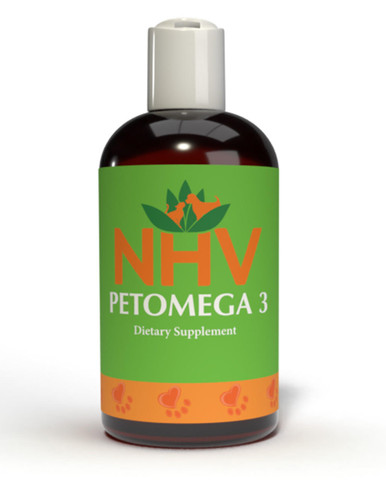
An Omega 3 supplement for cats to support their joints, heart, eyes, immune system, and overall organ function.

Our cat omega 3 supplement is naturally made from the oils of sardines, anchovies, and North Atlantic cod. It’s an excellent source of EPA (Eicosapentaenoic Acid 600mg) and DHA (Docosahexaenoic acid 460mg) essential omega 3 fatty acids. It’s molecularly distilled and cold-pressed to improve the bioavailability
Support your cat with human-grade quality omega 3 fish oil supplements. Many processed pet foods are deficient in this important nutrient. And according to the University of Maryland Medical Center, "It is very important to maintain a balance between omega-3 and omega-6 fatty acids in the diet. A proper balance helps maintain and even improve health."
It’s important for cats to get essential fatty acids through their diet. This omega 3 supplement for cats will help keep them healthy, and even finicky cats actually like to take it.
Benefits of Cat omega 3 supplements:
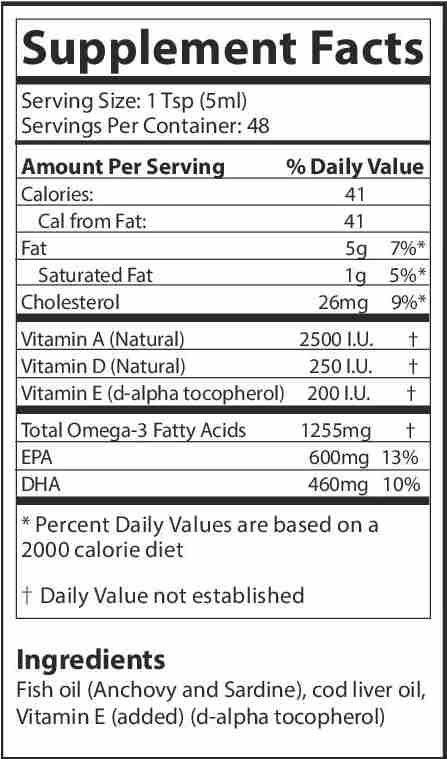
Suggested Dosage: To be taken once per day. Add to food based on weight chart.
Therapeutic Dosage: Double the quantity for maximum period of 4 weeks or follow veterinarian advise.
Pet’s Weight Dosage
0-15 lb = ¼ tsp
15-30 lb = ½ tsp
30-60 lb = 1 tsp
60-90 lb = 1 ½ tsp
How to Administer: Shake well before use. The easiest method is to add the dosage to your pets food. Some pets can be finicky, if this occurs consider hiding the appropriate amount in food most pet’s love such as fish, chicken, yogurt, or a favorite treat. If your pet only eats dry food then soak kibbles at feeding time.
For Best Results
Dietary supplements are beneficial to the health and well-being of your pet and are safe for long-term use. Every pet responds to natural supplements differently, therefore it is important to be consistent and administer the product daily. Supplements generally take two to four weeks to take effect, however this will vary from one animal to the next.
Product Storage
All NHV Natural Pet Products contain no artificial additives, preservatives or coloring. Shelf life after opening is 6 months and must be refrigerated after opening.
Cautions and Contraindications
Avoid During Pregnancy.
Our cat omega 3 supplement is naturally made from the oils of sardines, anchovies, and North Atlantic cod. It’s an excellent source of EPA (Eicosapentaenoic Acid 600mg) and DHA (Docosahexaenoic acid 460mg) essential omega 3 fatty acids. It’s molecularly distilled and cold-pressed to improve the bioavailability
Support your cat with human-grade quality omega 3 fish oil supplements. Many processed pet foods are deficient in this important nutrient. And according to the University of Maryland Medical Center, "It is very important to maintain a balance between omega-3 and omega-6 fatty acids in the diet. A proper balance helps maintain and even improve health."
It’s important for cats to get essential fatty acids through their diet. This omega 3 supplement for cats will help keep them healthy, and even finicky cats actually like to take it.
Benefits of Cat omega 3 supplements:

Suggested Dosage: To be taken once per day. Add to food based on weight chart.
Therapeutic Dosage: Double the quantity for maximum period of 4 weeks or follow veterinarian advise.
Pet’s Weight Dosage
0-15 lb = ¼ tsp
15-30 lb = ½ tsp
30-60 lb = 1 tsp
60-90 lb = 1 ½ tsp
How to Administer: Shake well before use. The easiest method is to add the dosage to your pets food. Some pets can be finicky, if this occurs consider hiding the appropriate amount in food most pet’s love such as fish, chicken, yogurt, or a favorite treat. If your pet only eats dry food then soak kibbles at feeding time.
For Best Results
Dietary supplements are beneficial to the health and well-being of your pet and are safe for long-term use. Every pet responds to natural supplements differently, therefore it is important to be consistent and administer the product daily. Supplements generally take two to four weeks to take effect, however this will vary from one animal to the next.
Product Storage
All NHV Natural Pet Products contain no artificial additives, preservatives or coloring. Shelf life after opening is 6 months and must be refrigerated after opening.
Cautions and Contraindications
Avoid During Pregnancy.
overall vitality
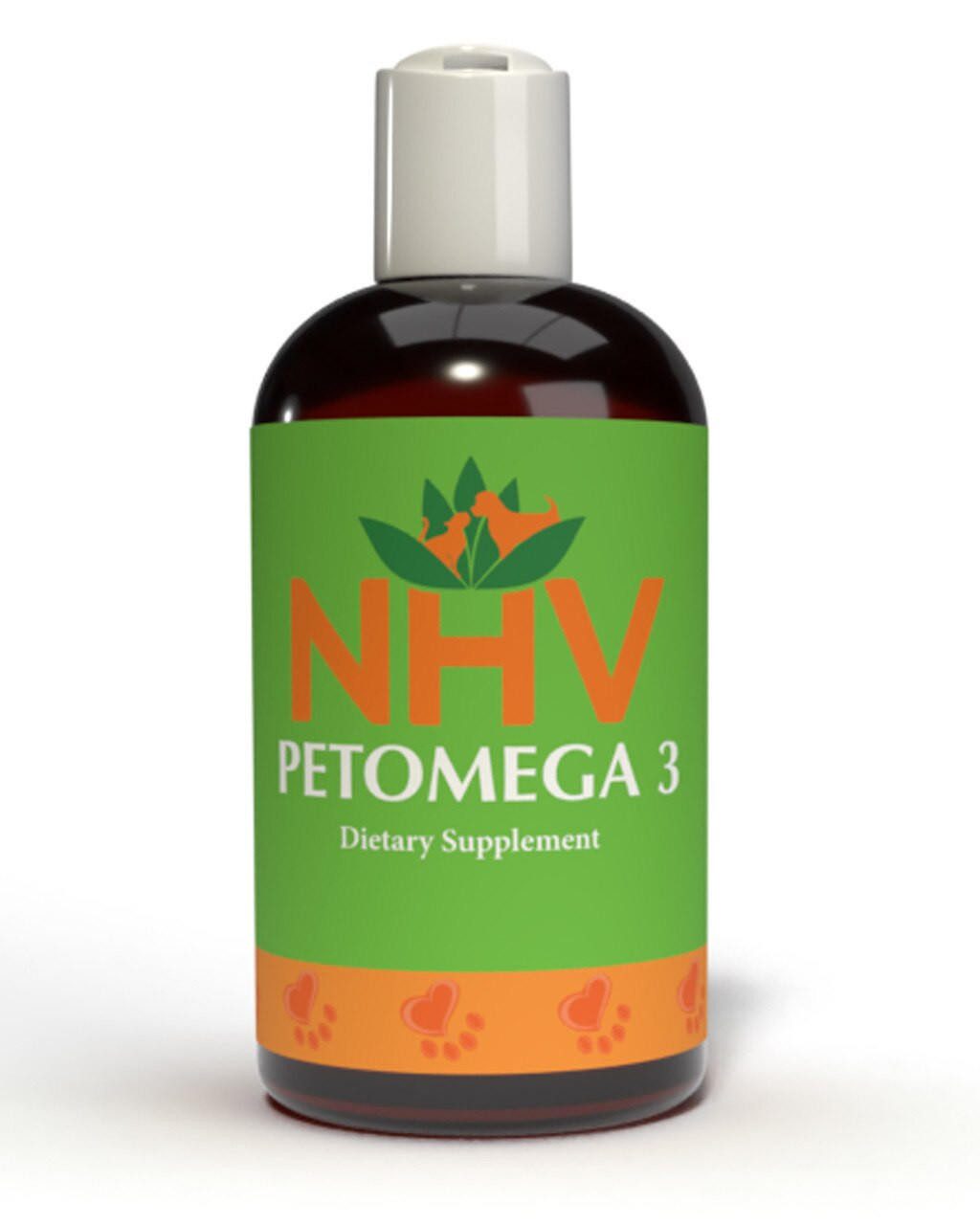
For Overall Health and Well-Being
buy 2 and save $3
Support your dog’s health with omega 3 fish oil for dogs. Help them maintain a healthy coat, eyes, joints, immune system and overall organ function.


Support your dog’s health with omega 3 fish oil for dogs. Help them maintain a healthy coat, eyes, joints, immune system and overall organ function.

Our omega 3 fish oil for dogs is a great source of EPA (Eicosapentaenoic Acid 600mg) and DHA (Docosahexaenoic acid 460mg) essential fatty acids. This fish oil supplement for dogs is derived from sardines, anchovies and North Atlantic cod liver oil. It is molecularly distilled and cold pressed to improve the bioavailability of the omega 3 fatty acids, and is medical and human grade quality.
Omega 3 fish oil for dogs may be beneficial for the following:
Processed pet foods have increased omega-6 fatty acids, and decreased omega-3 fatty acids. The University of Maryland Medical Center states, "It is very important to maintain a balance between omega-3 and omega-6 fatty acids in the diet. A proper balance helps maintain and even improve health." Your dog’s body cannot easily make essential fatty acids. It is vital to provide omega 3 fish oil for dogs as an added supplement to your pet’s daily diet.
The American Journal of Veterinary Medicine has published studies on the benefits of omega 3 fatty acids (fish oils) for arthritis and degenerative joint disease in dogs. The studies showed that dogs who were given omega 3 fatty acids had a significantly improved ability to get up from a resting position and marked improvement in walking ability.

Suggested Dosage: To be taken once per day. Add to food based on weight chart.
Therapeutic Dosage: Double the quantity for maximum period of 4 weeks or follow veterinarian advise.
Pet’s Weight Dosage
0-15 lb = ¼ tsp
15-30 lb = ½ tsp
30-60 lb = 1 tsp
60-90 lb = 1 ½ tsp
How to Administer: Shake well before use. The easiest method is to add the dosage to your pets food. Some pets can be finicky, if this occurs consider hiding the appropriate amount in food most pet’s love such as fish, chicken, yogurt, or a favorite treat. If your pet only eats dry food then soak kibbles at feeding time.
For Best Results
Dietary supplements are beneficial to the health and well-being of your pet and are safe for long-term use. Every pet responds to natural supplements differently, therefore it is important to be consistent and administer the product daily. Supplements generally take two to four weeks to take effect, however this will vary from one animal to the next.
Product Storage
All NHV Natural Pet Products contain no artificial additives, preservatives or coloring. Shelf life after opening is 6 months and must be refrigerated after opening.
Cautions and Contraindications
Avoid During Pregnancy.
Our omega 3 fish oil for dogs is a great source of EPA (Eicosapentaenoic Acid 600mg) and DHA (Docosahexaenoic acid 460mg) essential fatty acids. This fish oil supplement for dogs is derived from sardines, anchovies and North Atlantic cod liver oil. It is molecularly distilled and cold pressed to improve the bioavailability of the omega 3 fatty acids, and is medical and human grade quality.
Omega 3 fish oil for dogs may be beneficial for the following:
Processed pet foods have increased omega-6 fatty acids, and decreased omega-3 fatty acids. The University of Maryland Medical Center states, "It is very important to maintain a balance between omega-3 and omega-6 fatty acids in the diet. A proper balance helps maintain and even improve health." Your dog’s body cannot easily make essential fatty acids. It is vital to provide omega 3 fish oil for dogs as an added supplement to your pet’s daily diet.
The American Journal of Veterinary Medicine has published studies on the benefits of omega 3 fatty acids (fish oils) for arthritis and degenerative joint disease in dogs. The studies showed that dogs who were given omega 3 fatty acids had a significantly improved ability to get up from a resting position and marked improvement in walking ability.

Suggested Dosage: To be taken once per day. Add to food based on weight chart.
Therapeutic Dosage: Double the quantity for maximum period of 4 weeks or follow veterinarian advise.
Pet’s Weight Dosage
0-15 lb = ¼ tsp
15-30 lb = ½ tsp
30-60 lb = 1 tsp
60-90 lb = 1 ½ tsp
How to Administer: Shake well before use. The easiest method is to add the dosage to your pets food. Some pets can be finicky, if this occurs consider hiding the appropriate amount in food most pet’s love such as fish, chicken, yogurt, or a favorite treat. If your pet only eats dry food then soak kibbles at feeding time.
For Best Results
Dietary supplements are beneficial to the health and well-being of your pet and are safe for long-term use. Every pet responds to natural supplements differently, therefore it is important to be consistent and administer the product daily. Supplements generally take two to four weeks to take effect, however this will vary from one animal to the next.
Product Storage
All NHV Natural Pet Products contain no artificial additives, preservatives or coloring. Shelf life after opening is 6 months and must be refrigerated after opening.
Cautions and Contraindications
Avoid During Pregnancy.
cut & wound support
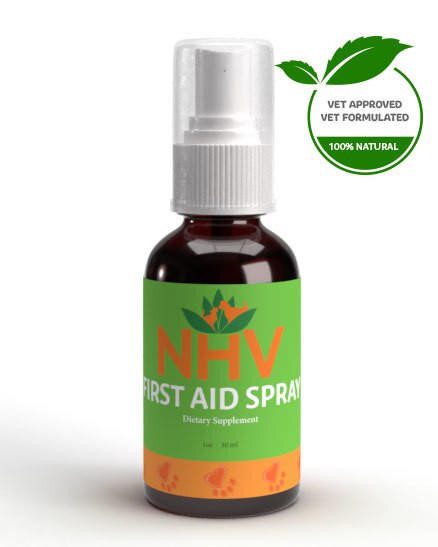
Natural Topical Spray for Cat Wounds
buy 2 and save $3
As pet parents, we know how much trouble our kitties can get into! Most households have a first-aid kit for humans but are unaware of what to do regarding minor pet emergencies, like a small cut or wound. Having a spray like NHV Cat First-Aid Spray is essential for soothing cuts and scrapes on the go or at home.


As pet parents, we know how much trouble our kitties can get into! Most households have a first-aid kit for humans but are unaware of what to do regarding minor pet emergencies, like a small cut or wound. Having a spray like NHV Cat First-Aid Spray is essential for soothing cuts and scrapes on the go or at home.

Natural Disinfectant Spray for Cat Wounds
Are you prepared for a pet emergency? Most households have a first-aid kit for humans and a basic understanding of human first aid but are unaware of what to do regarding minor pet emergencies. Accidents and injuries can happen anytime so having a cat first aid kit is essential for providing immediate care but is by no means a replacement for proper veterinary care. If your kitty is experiencing any emergency (major or minor), please take them to your trusted vet or emergency veterinary hospital as soon as you can. Also, do keep in mind that cats are very sensitive creatures and when they experience discomfort or stress, they may bite or scratch, so take special care to protect yourself.
How NHV’s Cat First-Aid Spray Supports Healing and Recovery
Cats are highly sensitive, intuitive creatures so even the smallest cut or scratch can cause extreme distress. Ingredients like Neem and Tea Tree oil contain natural disinfectant properties for cleaning wounds and discouraging the development of pathogenic infections. The sedative properties in California Poppy help relax your furry friend’s muscles to reduce stress, encourage healing, and help with discomfort. Aloe Vera’s highly effective antifungal and antibacterial properties are comparable to silver sulfadiazine (a common prescription cream used for treating and preventing infection). Ingredients like Marigold and Usnea, promote faster recovery by offering many beneficial wound and skin-healing compounds.
The Basics of Cat Emergency Care
These are the most important items for building a cat first aid kit:
Support Your Pet Naturally with NHV Supplements
All of our products are 100% natural and formulated by a holistic veterinarian and a master herbalist with more than 50+ years of experience. For any questions about pet first aid or how to prepare for a trip with your furry companion, contact an NHV Pet Expert.
Made with the finest, organically grown, or ethically harvested herbs. Made specifically for pets, vet-formulated and vet approved.
Topical Spray: Spray several times a day to the affected area(s) until healed.
It may sometimes be necessary to shave or trim your pet’s hair so that the First Aid spray reaches the affected area. If necessary, cover the affected area(s) with gauze dressing.
Caution
Do not spray near or into your eyes or nose. May initially sting on open cut
Natural Disinfectant Spray for Cat Wounds
Are you prepared for a pet emergency? Most households have a first-aid kit for humans and a basic understanding of human first aid but are unaware of what to do regarding minor pet emergencies. Accidents and injuries can happen anytime so having a cat first aid kit is essential for providing immediate care but is by no means a replacement for proper veterinary care. If your kitty is experiencing any emergency (major or minor), please take them to your trusted vet or emergency veterinary hospital as soon as you can. Also, do keep in mind that cats are very sensitive creatures and when they experience discomfort or stress, they may bite or scratch, so take special care to protect yourself.
How NHV’s Cat First-Aid Spray Supports Healing and Recovery
Cats are highly sensitive, intuitive creatures so even the smallest cut or scratch can cause extreme distress. Ingredients like Neem and Tea Tree oil contain natural disinfectant properties for cleaning wounds and discouraging the development of pathogenic infections. The sedative properties in California Poppy help relax your furry friend’s muscles to reduce stress, encourage healing, and help with discomfort. Aloe Vera’s highly effective antifungal and antibacterial properties are comparable to silver sulfadiazine (a common prescription cream used for treating and preventing infection). Ingredients like Marigold and Usnea, promote faster recovery by offering many beneficial wound and skin-healing compounds.
The Basics of Cat Emergency Care
These are the most important items for building a cat first aid kit:
Support Your Pet Naturally with NHV Supplements
All of our products are 100% natural and formulated by a holistic veterinarian and a master herbalist with more than 50+ years of experience. For any questions about pet first aid or how to prepare for a trip with your furry companion, contact an NHV Pet Expert.
Made with the finest, organically grown, or ethically harvested herbs. Made specifically for pets, vet-formulated and vet approved.
Topical Spray: Spray several times a day to the affected area(s) until healed.
It may sometimes be necessary to shave or trim your pet’s hair so that the First Aid spray reaches the affected area. If necessary, cover the affected area(s) with gauze dressing.
Caution
Do not spray near or into your eyes or nose. May initially sting on open cut
Published: June 22, 2018